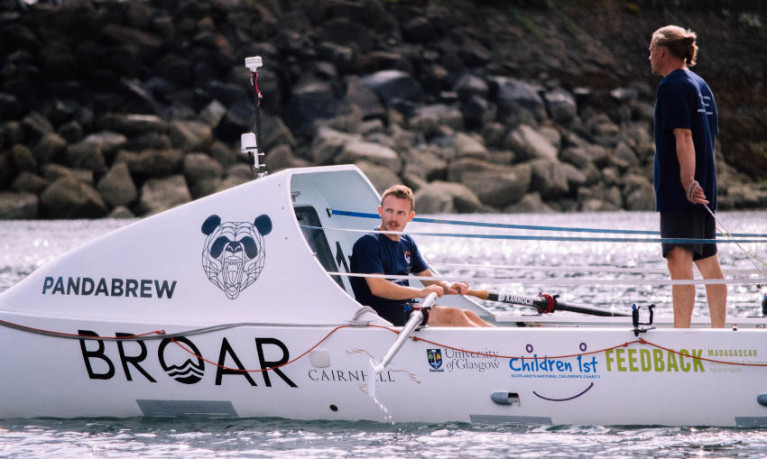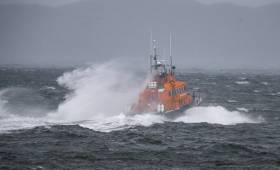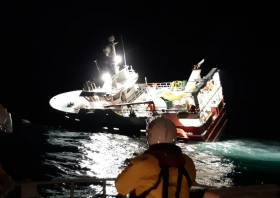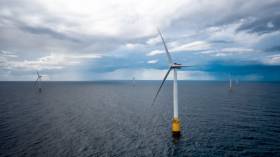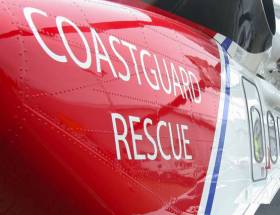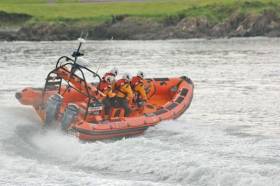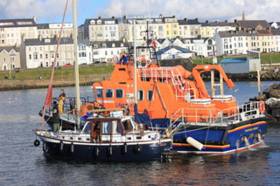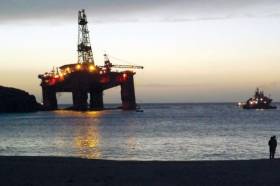Displaying items by tag: Scotland
Scottish Brothers Set Trio Of Records In Transatlantic Rowing Challenge
Three brothers from Scotland have set a trifecta of world records after rowing across the Atlantic Ocean in just over a month.
According to BBC News, Jamie, Ewan and Lachlan MacLean are the first three brothers to row any ocean, and the youngest trio and the fastest trio to ever row the Atlantic.
The brothers, collectively known as Broar, took just 35 days and change to row from La Gomera in the Canary Islands to Antigua in the Caribbean — besting the previous record time for a trio by some six days.
They also placed third overall in the Talisker Whisky Atlantic Challenge, in which Irish duo the Salty Pair are hoping to have made their mark this time next year.
BBC News has much more on the story HERE.
Miracle dolphin Spirtle has returned to her home waters in the north-east of Scotland after her summer spent off Ireland’s south-west coast, as BBC News reports.
The bottlenose dolphin with a distinctive sunburn scar was spotted with her family group in the Moray Firth this past Tuesday (17 December) — four months and hundreds of miles away from their last sightings in the waters off Co Kerry.
Spirtle initially surprised marine wildlife experts when she survived a live stranding ordeal in 2016 in which she suffered severe sunburn — and again this past summer when she and a number of her group were tracked heading south from Scotland through the Irish Sea.
A spokesperson for Whale and Dolphin Conservation said 2019 “has been a very unusual year for this dolphin population’s movements around the UK and overseas to the Dutch coast — it might not be quite finished yet”.
In other news, the Irish Whale and Dolphin Group (IWDG) says competition for food “seems to be growing more intense” for fin whales in the waters off Co Waterford, who made a more fleeting visit than usual for this time of year.
Two Callouts & 120 Miles Covered By Oban Lifeboat This Weekend
It was a busy weekend for Oban RNLI in Western Scotland, with its lifeboat Mora Edith MacDonald responding to two separate incidents, covering over 120 miles.
The first call came Saturday afternoon (7 December) as the lifeboat launched in gale force winds and high seas, alongside the Islay RNLI lifeboat, to assist a 28m vessel that had lost steering in the Sound of Jura, just north of the MacCormaig Islands.
Islay were first to arrive on scene and it was established that the casualty vessel was able to make way using its emergency steering. Oban lifeboat was requested to rendezvous with the Islay volunteers and the casualty vessel to take over the escort.
Having battled high seas and poor visibility, the Oban crew arrived on scene shortly after 6pm.
While the casualty vessel was able to make way under its own power, the decision was made to continue escorting it to the safety of Craobh Haven Marina.
Given the weather conditions, with wind speeds of up to 50mph and the size of the vessel, it was decided that the Islay lifeboat should also remain on scene. The vessel made a steady speed north towards Craobh accompanied by both lifeboats.
On arrival at 8.15pm, the Oban lifeboat used its searchlights to illuminate the entrance in driving rain, giving the casualty vessel enough visibility to manoeuvre into the marina.
After several attempts at berthing in extremely challenging conditions, the vessel made it alongside with assistance from the Oban crew and, with the help of Craobh Haven Marina’s staff, the vessel was safely tied alongside by 9pm.
The second call came yesterday afternoon (Sunday 8 December) when the volunteer crew launched at 3pm to a report of a yacht adrift off Corpach.
The lifeboat made best speed in the conditions, arriving on scene by 4.30pm. Two crew members were put on board the yacht to determine whether anyone was on board.
With nothing found, it was decided a line would be put ashore to a nearby pier to ensure it didn’t drift further. The Fort William Coastguard Team were also on scene to take lines ashore and secure the vessel.
Lerwick Lifeboat Aids Crew Of Grounded Vessel
Lerwick lifeboat launched late Friday night (15 November) to the aid of a fishing vessel which had grounded on rocks just north of the Shetland Islands harbour.
The 26-metre, Inverness-registered trawler was stuck fast and was listing when the Severn-class all-weather lifeboat arrived on scene around 1.40am.
Lerwick Port Authority vessels Knab and Kebister, and the fishing vessel Faithlie, also arrived soon after to assist.
After assessing the damage, attempts by the lifeboat crew to tow the vessel off the rocks on a falling tide were unsuccessful, with two tow lines on the lifeboat snapped in the effort. The other vessels on scene were also unable to free the trawler from the rock.
The nine crew members were taken off the stricken vessel by the lifeboat around 4am and safely returned to Lerwick Harbour, with only minor injuries, and into the care of the ambulance service.
Weather conditions were calm with light winds and a moderate sea swell, with the air temperature just above freezing.
Around 12 hours later, the lifeboat returned to the scene to assist with another attempt to refloat the vessel at high tide, just before 1pm on Saturday.
The Knab and Kebister were successful in pulling the vessel off the rocks on Saturday afternoon and took the vessel under tow into Lerwick Harbour, accompanied by Lerwick lifeboat.
Lerwick RNLI’s deputy coxswain Tommy Goudie said: “The outcome of this grounding could have been a lot worse. Thanks to fair weather and the combined efforts of ourselves and Lerwick Port Authority vessels, the fishing crew are safe, and the vessel is now safely in harbour.
“The crew did the right thing by contacting the coastguard as soon as they knew they needed help. They were wearing survival suits and life jackets and deployed their life raft in case it became necessary. Our crew are always ready to respond and we’re pleased to be able to assist.”
A new cruise berthing and visitor centre at Greenock Ocean Terminal on the Forth of Clyde, Scotland has been confirmed, it was revealed today.
At its June meeting, the Glasgow City Region City Deal Cabinet approved a contribution of £9.693m from its overall £1bn pot, which is funded equally by the Scottish and UK governments.
The balance of the Marine and Landside Works will be paid for by Greenock Ocean Terminal operator Peel Ports (£8m) and the George Wyllie Foundation via arts funder the Dunard Trust (£1.5m).
The news comes as early stages of site work begins on the overall project, which is led by Peel Ports and Inverclyde Council.
The development, which is scheduled for completion in summer 2020, will boost the number of cruise ship passengers welcomed to Scotland through the successful Greenock facility.
It will allow up to 150,000 passengers per annum to pass through Greenock Ocean Terminal, delivering £26 million in annual visitor and crew spend to the Scottish economy.
In addition to the cruise berthing and the visitor centre designed by Richard Murphy Architects, the plans also include a purpose-built gallery celebrating the work of legendary Inverclyde artist George Wyllie and a restaurant with panoramic views across the Clyde.
Peel Ports Clydeport Port Director Andrew Hemphill said: “The confirmation of City Deal funding comes as the Terminal celebrates its 50th birthday. This overall investment is crucial to the remarkable growth of cruise traffic to Greenock, allowing us to create a welcoming and comfortable environment for passengers.
“Year on year, we are building a major cruise business on the Clyde and, thanks to the success of Greenock Ocean Terminal, more people than ever are taking a cruise to Scotland.
“Who 50 years ago would have anticipated the level of success we’ve had in bringing the world’s biggest container and cruise ships to Greenock? Now we are about to expand our capability further to attract thousands more visitors every year with the new development, up to 150,000 cruise passengers annually. It’s fantastic news for Inverclyde and for Scotland.”
Inverclyde Council Leader Councillor Stephen McCabe said: “The project is part of the Glasgow City Region City Deal and aims to boost the capacity at Greenock Ocean Terminal for cruise ships. The addition of a restaurant and Wyllie Gallery will help to provide a year-round attraction for visitors to Greenock and Inverclyde.
“As a key City Deal project, the new visitor centre at Greenock Ocean Terminal aims to make a significant contribution to economic growth and international tourism across the wider city region area.”
Greenock was named the top UK cruise destination, and placed in Western Europe’s top five, in the second Cruise Critic Cruisers’ Choice Destination Awards by Cruise Critic, a leading cruise review site. It has also been named as the most welcoming cruise terminal.
World’s First Floating Windfarm Now Powering Scotland
#Windfarm - The world’s first floating windfarm is now generating power for Scotland, according to BBC News.
Afloat.ie previously covered the Hywind Scotland project, backed by Norwegian energy giant Statoil, which comprises a series of giant wind turbines tethered to the seabed off the coast of Aberdeenshire.
The 6MW, 175-metre-tall turbines in this pilot project are said to generate enough energy to power as many as 20,000 homes.
Scotland’s First Minister Nicola Sturgeon officially opened the windfarm this week, saying it “underlines the potential of Scotland's huge offshore wind resource and positions Scotland at the forefront of the global race to develop the next generation of offshore wind technologies.”
Recently a tidal power station in the far north of Scotland announced it had broken the world record for electricity generation, as The Independent reports.
The company behind the MeyGen project say they generated 700 megawatt hours of energy in the month of August from its more than 250 turbines installed on the sea bed in the Pentland Firth between Orkney and the Scottish mainland.
#Surfing - “It was just… nothing. There is only blackness.”
That’s how Scottish surfer Matthew Bryce describes his terrifying ordeal adrift on his board in the North Channel for 32 hours.
According to the Belfast Telegraph, the 23-year-old recently returned to Campbelltown in Argyll a month after what was supposed to be a morning riding the waves turned into a nightmare.
The young man was finally rescued from the sea off Northern Ireland on 1 May, more than a day after getting pulled away from the shore, as previously reported on Afloat.ie.
Bryce expressed his appreciation to the local RNLI and coastguard teams, who worked with their counterparts in Northern Ireland to search the sea by boat and air.
He also appealed to anyone else going surfing to avoid the mistakes he made in surfing alone, without GPS or means to contact anyone on shore.
The Belfast Telegraph has much more on the story HERE.
#Missing - RNLI lifeboats from Bangor and Donaghadee have joined the search for a speedboat with two men missing off the Scottish coast, as BBC News reports.
Coastguard volunteers from Bangor are also part of the emergency operation launched last night (Saturday 6 May) when the two men failed to return to Port Logan in Dumfries and Galloway.
Searches for the missing vessel, thought to be an 18ft black Fletcher speedboat, are concentrated off the Mull of Galloway for the time being.
BBC News has more on the story HERE.
Portrush Lifeboat Assists Cruiser In Difficulty
#RNLI - Portrush RNLI’s volunteer lifeboat crew got an early callout yesterday morning (Sunday 5 March) on reports of a cruiser with three on board that had got into difficulties 33 miles offshore just south-east of the island of Islay in Scotland’s Inner Hebrides.
Weather conditions were described as ‘perfect’ with a bright morning pagers went off at 10.10am, and the crew were quickly underway at full speed due the favourable sea conditions.
When the lifeboat crew reached the vessel, a towline was quickly attached to the cruiser and it was taken under tow to Portrush at a slow and steady rate of six knots. The lifeboat crew returned to base by 4.30pm, six hours after launch.
Portrush RNLI lifeboat operations manager Robin Cardwell said: “This was a textbook exercise for the crew, and something they train for all year round. The good weather conditions assisted the recovery and good progress was made for home.”
Tugboats Refloat Oil Rig that Grounded Off Isle of Lewis
#OilRig - Tugboats from Smit Salvage have tugged the 17,000-tonne Transocean Winner free during high water levels and will be taken Broad Bay on the Isle of Lewis, Scotland until it can be transported to a repair facility.


























